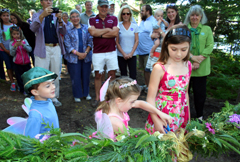 |
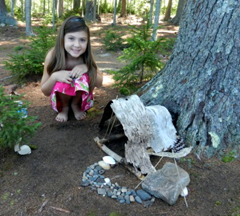 |
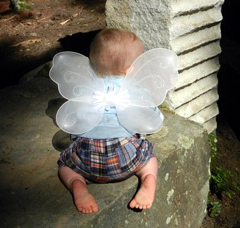 |
 |
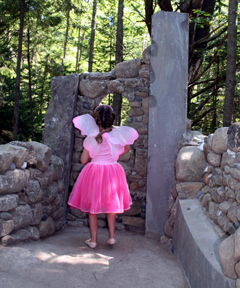 |
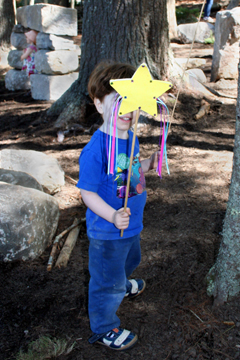 |
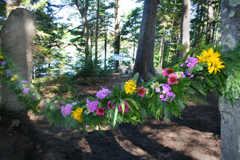 |
After exhaustive research, Coastal Maine Botanical Gardens Executive Director William Cullina gleaned the following historical information from an academic paper by Dr. Wallace McBride, “Fairy Communities of the Central Maine Coast,” published in the American Journal of Fairy and Elven Studies, vol. 16:3, pp. 231-244. He read this document to the children and their grown-ups assembled for the opening celebration and garland cutting for the Gardens’ shoreland Fairy House Village on Saturday, August 24, 2013.
It is thought that fairies first left Tir na nog, the land of external youth, about 65 million years ago, to help heal the earth from the devastating effects of the asteroid impact that plunged the world into darkness and chaos. It is believed that the origin of the four fairy clans – air, water, fire and tree fairies – can be traced to this time. As little as 10,000 years ago, fairies are said to have been living commonly and openly in the Irish and Welsh countryside, serving as healers and holding fairy court where accused violators of natural law could be heard and reprimanded. These “fairy circles,” as they are called, evolved into community gathering places where important events such as the turning of the four seasons and the birth of the full moon are celebrated.
Just as happened elsewhere in the world, when humans arrived in Ireland, Wales and Scotland 10,000 years ago they feared these tiny magical creatures and worked to drive them away by destroying their houses and circles. Though it is likely that many fairies returned to Tir na nog during Amanna dorcha (the dark times), as this period was called, others retreated to the forests and the night, using magic and trickery to help keep humans from discovering them. To this day, much of what we call coincidence and luck is really this fairy magic and trickery.
In 1989, the discovery of the Rockland Runes on a beach just south of the Samoset Resort marked a major turning point in our understanding of fairy history in this region. This two-by-three-foot stone, with its intricately carved runic characters, tells the story of the great fairy crossing, or Turas. We now know that during the Amanna dorcha a small band of water fairies set sail from western Ireland in their shell-shaped wooden boats, destined for Tir na nog but were caught in a great storm that blew them far south into the Sargasso Sea near Bermuda. Their boats wrecked, they floated on great mats of Sargasso seaweed for two moons until by chance they caught a ride on on the backs of migrating silver eels, or elvers, as they swam northwest to the rivers along Maine’s midcoast. Exhausted and lost, the weary band made landfall on Monhegan Island and established a small settlement.
Over time the fairies flew to the closer islands and mainland around what is now Boothbay Harbor and developed thriving communities. Even the name Boothbay comes from Beal Ba, fairy for “mouth bay.” Here the water fairies lived openly and peacefully for more than 9,000 years, until the arrival of English, Scottish and Irish settlers signaled yet another Amanna dorcha that drove the fairies into hiding again. Even as late as the mid 1800s, fairy sightings in this area were common, but nowadays they are increasingly rare as fairy houses and circles are inadvertently destroyed to make way for modern things.
While constructing the Shoreland Trail at Coastal Maine Botanical Gardens in the late 1990s, volunteers discovered a small fairy village on this very site. Although apparently unoccupied, it was obvious that the village was quite old and likely dated from the first settlement of the mainland by the Monhegan water fairies nearly 8,000 years ago. Much of the site was in ruins, as a result of the land clearing for sheep farming here in the 19th century, but part of the circle and some of the dwellings remained. Worried by the decline of the fairy community, young volunteers began rebuilding the houses and, happily, within a short time the fairies returned.
As Bill Cullina explained at the celebration, “When the current work is complete, the Ciorcal Mór (Great Circle) will again stand as the largest and most important ceremonial site of its kind in Maine. Joe Norton has also rebuilt the north and east walls of the famous Te-ach Uisce, or Water House, mentioned in the Rockland Runes, and over the course of the fall and winter he will add the symbols and runic characters to the various structures as described in the Rockland document. It makes my heart glad that in this garden of wonder and beauty we have provided a place for these ancient creatures and the magic and nature they represent. “
He thanked the Walbridge family for making the restoration possible and Joe Norton and his crew for the vision and hard work to build it.
“Now, to complete the work and bring magic to the stones,” he concluded, “we ask the children in the audience to sprinkle them with this fairy dust discovered during excavation of the site. Then, to welcome the fairies home, we would be grateful if you would build them houses great and small to show the little people they are most welcome here. Thank you and siúl i síocháin (walk in peace).”

